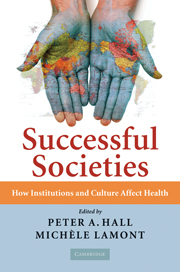Book contents
- Frontmatter
- Contents
- Contributors
- Preface
- Introduction
- 1 Population Health and the Dynamics of Collective Development
- 2 Social Interactions in Human Development: Pathways to Health and Capabilities
- 3 Health, Social Relations, and Public Policy
- 4 Population Health and Development: An Institutional-Cultural Approach to Capability Expansion
- 5 Responding to AIDS in Sub-Saharan Africa: Culture, Institutions, and Health
- 6 Responses to Racism, Health, and Social Inclusion as a Dimension of Successful Societies
- 7 Collective Imaginaries and Population Health: How Health Data Can Highlight Cultural History
- 8 Making Sense of Contagion: Citizenship Regimes and Public Health in Victorian England
- 9 The Multicultural Welfare State?
- 10 From State-Centrism to Neoliberalism: Macro-Historical Contexts of Population Health since World War II
- Bibliography
- Index
Introduction
Published online by Cambridge University Press: 05 June 2012
- Frontmatter
- Contents
- Contributors
- Preface
- Introduction
- 1 Population Health and the Dynamics of Collective Development
- 2 Social Interactions in Human Development: Pathways to Health and Capabilities
- 3 Health, Social Relations, and Public Policy
- 4 Population Health and Development: An Institutional-Cultural Approach to Capability Expansion
- 5 Responding to AIDS in Sub-Saharan Africa: Culture, Institutions, and Health
- 6 Responses to Racism, Health, and Social Inclusion as a Dimension of Successful Societies
- 7 Collective Imaginaries and Population Health: How Health Data Can Highlight Cultural History
- 8 Making Sense of Contagion: Citizenship Regimes and Public Health in Victorian England
- 9 The Multicultural Welfare State?
- 10 From State-Centrism to Neoliberalism: Macro-Historical Contexts of Population Health since World War II
- Bibliography
- Index
Summary
Across time and space, the social fabric is woven differently. How do differences among societies affect the well-being of those who live in them? Are some types of societies more successful than others at promoting individual lives and the collective development of the community? How might the character of a society have such effects, and how are such societies built? These are large questions of classic interest to the social theorists of modernity, such as Comte, Tocqueville, Durkheim, Weber, and Marx, with a pedigree that stretches back to the utopian writings of Bacon, More, and Saint-Simon.
In recent years, however, social science has been more reluctant to tackle such questions. There are good reasons for caution. Post-Enlightenment thought observes that the success of a society is difficult to define independently of complex normative issues, not least because trade-offs must often be struck between goals or groups. Assessing the multifaceted web of social relations connecting members of society also poses major empirical challenges. Even the most promising studies in contemporary social science usually fasten onto one or two dimensions of it to the exclusion of others. Their formulations reflect a balkanization among disciplines that has seen some scholars focus on strategic interaction, while others concentrate on symbolic representations or psychosocial processes, each construing institutions and human motivation in different terms.
There is something becoming in the modesty of contemporary social science. It has made focused empirical inquiry more practicable. But something has also been lost.
- Type
- Chapter
- Information
- Successful SocietiesHow Institutions and Culture Affect Health, pp. 1 - 22Publisher: Cambridge University PressPrint publication year: 2009
- 8
- Cited by



